5.2: Nets and Surface Area
( \newcommand{\kernel}{\mathrm{null}\,}\)
Lesson
Let's use nets to find the surface area of polyhedra.
Exercise \PageIndex{1}: Matching Nets
Each of the nets can be assembled into a polyhedron. Match each net with its corresponding polyhedron, and name the polyhedron. Be prepared to explain how you know the net and polyhedron go together.


Exercise \PageIndex{2}: Using Nets to Find Surface Area
- Name the polyhedron that each net would form when assembled.
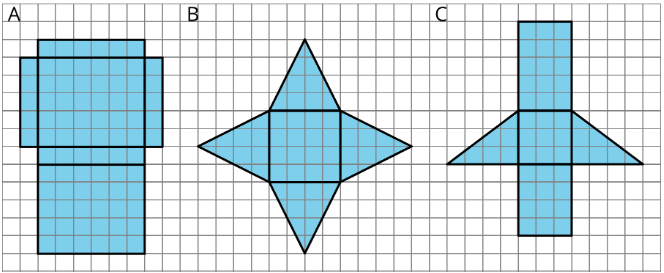
- Your teacher will give you the nets of three polyhedra. Cut out the nets and assemble the three-dimensional shapes.
- Find the surface area of each polyhedron. Explain your reasoning clearly.
Are you ready for more?
- For each net, decide if it can be assembled into a rectangular prism
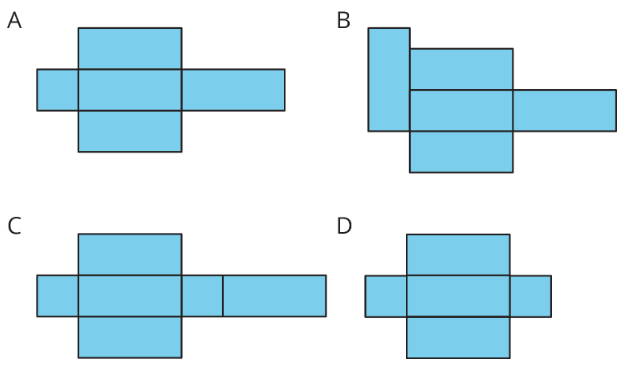
- For each net, decide if it can be folded into a triangular prism.
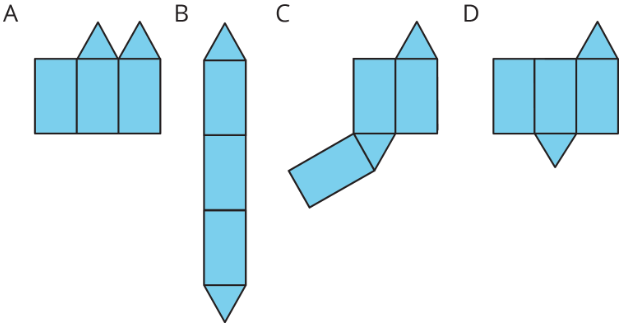
Summary
A net of a pyramid has one polygon that is the base. The rest of the polygons are triangles. A pentagonal pyramid and its net are shown here.
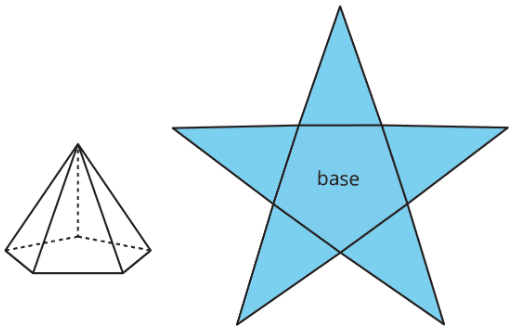
A net of a prism has two copies of the polygon that is the base. The rest of the polygons are rectangles. A pentagonal prism and its net are shown here.
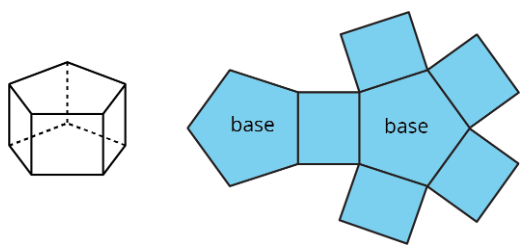
In a rectangular prism, there are three pairs of parallel and identical rectangles. Any pair of these identical rectangles can be the bases.
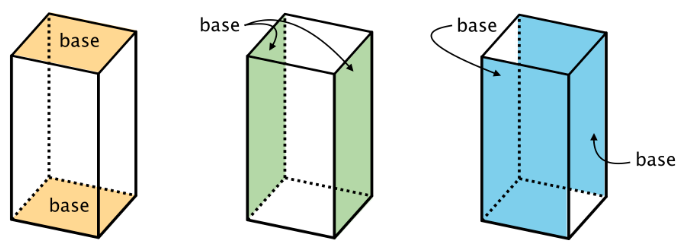
Because a net shows all the faces of a polyhedron, we can use it to find its surface area. For instance, the net of a rectangular prism shows three pairs of rectangles: 4 units by 2 units, 3 units by 2 units, and 4 units by 3 units.
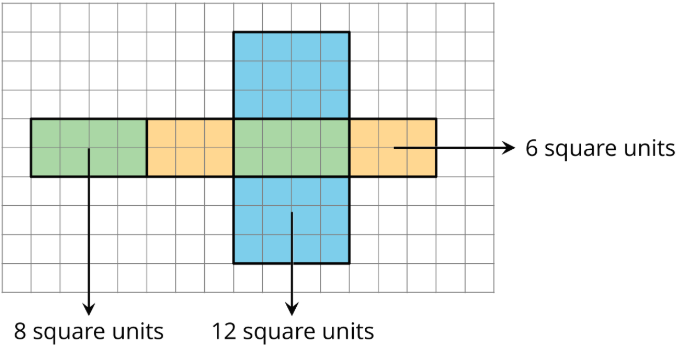
The surface area of the rectangular prism is 52 square units because 8+8+6+6+12+12=52.
Glossary Entries
Definition: Base (of a Prism or Pyramid)
The word base can also refer to a face of a polyhedron.
A prism has two identical bases that are parallel. A pyramid has one base.
A prism or pyramid is named for the shape of its base.
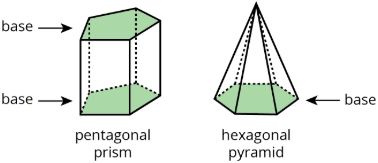
Definition: Face
Each flat side of a polyhedron is called a face. For example, a cube has 6 faces, and they are all squares.
Definition: Net
A net is a two-dimensional figure that can be folded to make a polyhedron.
Here is a net for a cube.
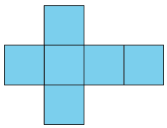
Definition: Polyhedron
A polyhedron is a closed, three-dimensional shape with flat sides. When we have more than one polyhedron, we call them polyhedra.
Here are some drawings of polyhedra.
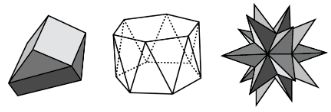
Definition: Prism
A prism is a type of polyhedron that has two bases that are identical copies of each other. The bases are connected by rectangles or parallelograms.
Here are some drawings of prisms.
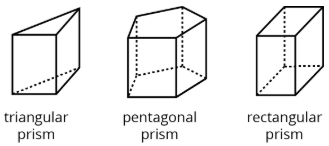
Definition: Pyramid
A pyramid is a type of polyhedron that has one base. All the other faces are triangles, and they all meet at a single vertex.
Here are some drawings of pyramids.

Definition: Surface Area
The surface area of a polyhedron is the number of square units that covers all the faces of the polyhedron, without any gaps or overlaps.
For example, if the faces of a cube each have an area of 9 cm2, then the surface area of the cube is 6\cdot 9, or 54 cm2.
Practice
Exercise \PageIndex{3}
Can this net be assembled into a cube? Explain how you know. Label parts of the net with letters or numbers if it helps your explanation.
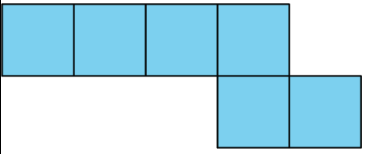
Exercise \PageIndex{4}
- What polyhedron can be assembled from this net? Explain how you know.
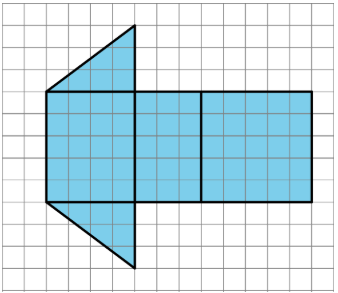
- Find the surface area of this polyhedron. Show your reasoning.
Exercise \PageIndex{5}
Here are two nets. Mai said that both nets can be assembled into the same triangular prism. Do you agree? Explain or show your reasoning.
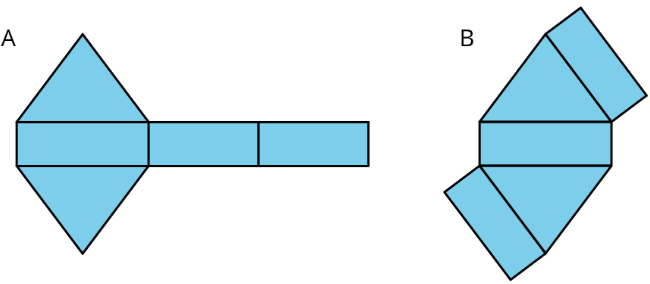
Exercise \PageIndex{6}
Here are two three-dimensional figures.
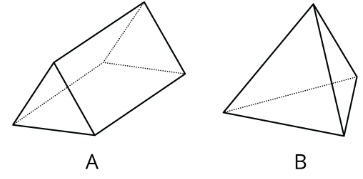
Tell whether each of the following statements describes Figure A, Figure B, both, or neither.
- This figure is a polyhedron.
- This figure has triangular faces.
- There are more vertices than edges in this figure.
- This figure has rectangular faces.
- This figure is a pyramid.
- There is exactly one face that can be the base for this figure.
- The base of this figure is a triangle.
- This figure has two identical and parallel faces that can be the base.
(From Unit 1.5.2)
Exercise \PageIndex{7}
Select all units that can be used for surface area.
- square meters
- feet
- centimeters
- cubic inches
- square inches
- square feet
(From Unit 1.5.1)
Exercise \PageIndex{8}
Find the area of this polygon. Show your reasoning.
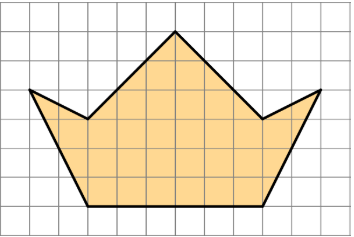
(From Unit 1.4.1)


